Damaraland is home to many extraordinary sites of historical and cultural interest and spectacular desert scenery. Tours and safaris offered by African Sky between the Skeleton Coast and Etosha pass through Damaraland. Khorixas, in central Damaraland, is populated by the Damara, who, with the San, are the oldest inhabitants in Namibia.
Need Advice?Twyfelfontein is Damaraland's most famous attraction. It is about 90km west of Khorixas and has the greatest collection of rock art anywhere. Around two thousand petroglyphs exist here.

Twyfelfontein was proclaimed a national monument in 1952. The rock engravings on the smooth rock surfaces depict different animals and their tracks. Scientists agree these engravings are between 1 000 and 10 000 years old. Other attractions in the area include; the 'Petrified Forest' with 300 million-year-old tree trunks. Some 150km south of Khorixas lies the Brandberg Massif, Namibia's highest mountain.
The southern and northern parts of Namibia are explored on this private tour accompanied by an experienced African Sky guide.
Swakopmund, the Skeleton Coast, Damaraland, and Etosha National Park are the focus of this privately guided tour of northern Namibia.
Damaraland's arid landscape is home to exceptional lodges in truly unique and inspirational settings.
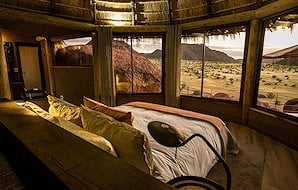
Built into a rocky outcrop with splendid views of the Aba Huab Valley, this luxury lodge offers an intimate natural and cultural experience in Damaraland.
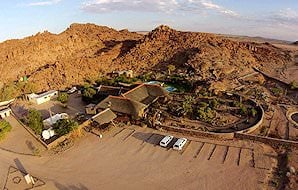
Brandberg White Lady offers accommodations, from camping to basic but comfortable permanent tents and rooms.
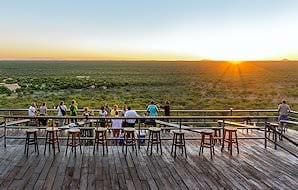
Damara Mopane Lodge is an oasis in arid surroundings. The lodge is comfortable though not luxurious, with an ideal location near Khorixas.
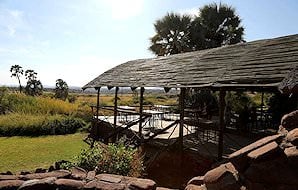
Between Damaraland and the Skeleton Coast, Palmwag Lodge offers a huge concession for nature activities and quality though not luxurious, accommodation.
Damaraland is a vast untamed expanse. Its inhabitants are limited to the native Damara people, the desert elephant, the rhino, and a minority of other animals that cross the barren region to find water sources. The air is free from pollution and unnatural lights, and almost all nights are clear, which makes it a perfect place to observe the constellations.
The region has a harsh climate and brutal terrain, but being one of the driest places on the continent has its perks – the landscapes formed by hundreds of millions of years of erosion make this mountainous area strikingly beautiful. Boulders the size of trees, gorges, crevices, and tufted plains are found in the region.
The different qualities of the landscape and its inhabitants make Damaraland an ideal location for any photographer or cinematographer that wants to up their game. Capturing the essence of this region is a challenge that will require determination and perseverance, but the results are guaranteed to be worth it.
As a destination, Damaraland is sought-after for the unique cultural and archaeological experiences available. From meeting the local Damara people to exploring the ancient rock art sites.
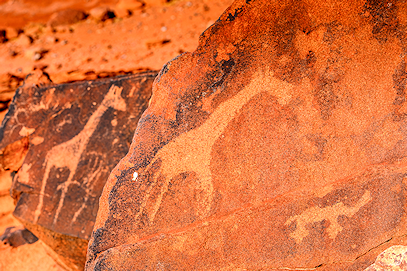
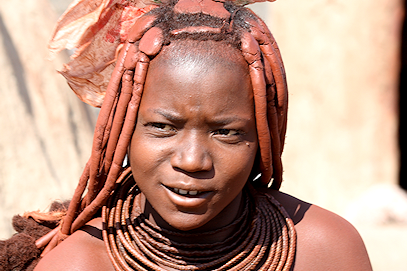
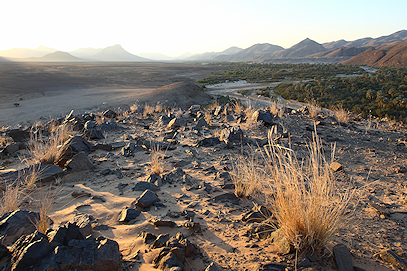
Guests traveling to Damaraland will need to fly to Namibia. Upon arrival at OR Tambo International Airport, guests will be welcomed and assisted in transferring to a flight bound for Windhoek's Hosea Kutako International Airport. Guests traveling to the northern reaches of Damaraland may be chartered via a light aircraft to one of the private landing strips.
Most guests on safari in Namibia will travel from Windhoek northwest to the Skeleton Coast and continue further north to Damaraland. Travelers booking with African Sky will be transported in a private, air-conditioned vehicle by an experienced guide on this journey.
Damaraland is dry throughout the year. You can visit any time, but the animals converge around any available water sources during the arid winter months. It makes May to September the best season for wildlife viewing. It is also much cooler in the winter than in the summer, which makes daytime activities more enjoyable.
The summer can become hot and uncomfortable for some, but if the area receives a good amount of rain, the grasslands become a hotspot for gemsbok and springbok. Elephants migrate through the area throughout the year and are seen in the dry and wet seasons. If you are planning a trip to a wildlife reserve or park in combination with Damaraland, the dry season is the best time to visit.
Named after the local Damara tribe, the name means 'black people' in the Khoekhoe language. Very little is known about their origins, but it is thought that they are a remnant population of hunter-gatherers. Oral tradition has it that they came from the equatorial rainforest. Occupying the area for thousands of years alongside the San, the Damara had a similar lifestyle but also cultivated crops and were even able to work iron into knives, ornaments, and spearheads.
Thousands of Bushman paintings and engravings can shed some light onto the lifestyle of the San hunter-gatherers that occupied the area. At Brandberg, one can find one of the most famous Bushman paintings in Namibia – "the White Lady" – which is most likely a man because he is carrying a bow and arrow. Twyfelfontein in Damaraland is Namibia's – and possibly the world's – best preserved Bushman rock engraving site, featuring more than 2 000 engravings and a multitude of rock paintings. Twyfelfontein became a World Heritage Site in 1952 to preserve this gem of anthropological history. Here you can look back on your history and imagine how people lived thousands of years ago.
Even though it is one of the driest places on the African continent, it contains a remarkable variety of wildlife. Oddly enough, the world's largest land mammal, the elephant, has adapted to survive here, and the region boasts a healthy population of these desert-adapted giants. There is even some highly endangered black rhino that has also adapted to this harsh desert environment. The area has sub-surface water – which allows trees to grow – providing kudu and giraffes with good browsing. The dazzling Hartmann's mountain zebra also occur. Herds of desert 'experts' like the gemsbok (oryx) and springbok are plentiful.
Gemsbok has no water dependence, meaning that they are not dependent on surface water but rather obtain the water they need from the plants they eat. All these herbivores attract a surprising amount of carnivores that move in and around the area. These include lions, cheetahs, spotted hyenas, and brown hyenas. Many smaller creatures like bat-eared foxes, Damara ground squirrels, and Kaokoveld rock hyrax are present alongside many reptiles, particularly lizards. Birders could spot more than 240 species.
Set in one of the prehistoric river valleys of Namibia, Damaraland is a massive, untamed region that encompasses granite mountains and koppies, open plains, grasslands, ancient forests, and endless sandy wastelands. The vastness of the terrain make it one of the most scenic areas in the country. It is best known for its distinctive geological attractions. The Brandberg Mountain, which translates roughly to "Burning" or "Fire" Mountain, is the highest in Namibia and towers dramatically over the region. It is not to be confused with Burnt Mountain in the Twyfelfontein area.
The area is one of the driest on the African continent, and surface waters are virtually non-existent. Yet, the area sustains a diverse range of lifeforms, including people, and has done so for thousands of years. It is made possible by remarkable desert vegetation, as sub-surface waters allow plants and trees to grow. Their roots are incredibly nutrient-rich, and animals kick the dusty ground to reveal them. Evidence of historical flooding, however, can be seen in the Petrified Forest, a collection of enormous fossilized tree trunks.
Damaraland is a photographer's dream. The landscapes and rocky outcrops set the most enchanting scene, especially when you glimpse the free-ranging desert elephants and iconic gemsbok. It is also a place of rich cultural heritage, and the ancient rock art sites, such as the "White Lady" bushman painting, appeal to visitors to the rugged landscape. Twyfelfontein is listed as a World Heritage Site because of the abundance of rock art engravings in the various caves. See the Vingerklip (which translates to "Finger Rock" in Afrikaans), a limestone tower that stands 35m high, or the Spitzkoppe – another Namibian landmark.
The area is also home to many animals, and game drives or guided walks through the region guarantee a unique safari experience. Birding is one of the much-loved activities for visitors to Damaraland, especially scouting for raptors and the flightless ostriches that roam the plains. A visit to the Petrified Forest is an out-of-this-world experience, and it is comparable to nothing you have ever witnessed. The fossilized tree trunks that belong to a family of trees commonly found in Europe today were washed down by one of the ancient rivers.